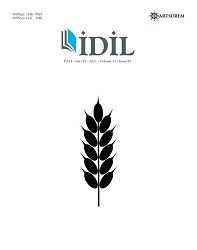TEKNOLOJİNİN BELİRLEYİCİLİĞİNDE MÜZELERDE DİJİTALLEŞME SÜRECİ VE İNSAN ODAKLI TASARIM YAKLAŞIMLARI
DETERMINATION OF TECHNOLOGY, THE DIGITALIZATION PROCESS IN MUSEUMS AND HUMAN-ORIENTED DESIGN APPROACHES
Author(s): Özlem VargünSubject(s): Museology & Heritage Studies, Electronic information storage and retrieval
Published by: Sanat ve Dil Araştırmaları Enstitüsü
Keywords: Post-digital age; human-centered design; experience design; digital footprint of museums; technological determination;
Summary/Abstract: The purpose of this article is to bring together in the historical framework how exhibition methods and approaches have changed in the transition from the digital age to the post-digital age, and how the technologies used are reflected in the virtual and digital existence of the museum. In this process, the transformation of changes in museums into human-oriented designs is discussed. In order to transfer the technology usages in the museum to the historical perspective, first of all, literature research was conducted, and the first technology uses and spread were transferred to the infographic. In the last section, especially the positive and negative aspects of virtual reality technologies in museums have been critically reinterpreted. According to the findings, museums started to create their first digital assets in 1990, and after 2000, it has been determined that user experience is important to make their digital assets more remarkable and recognizable with technological opportunities through web 2.0. In this process, there have been radical changes in the physical assets of museums, and museum exhibitions have evolved from static presentations to dynamic interactive exhibition designs. It has been seen that human-oriented experience design is used on the basis of this change. It has been determined that the technologies used in the experience designs used in the physical assets of the museums are preferred according to the characteristics of the collection and the museum strategies, and that virtual reality technologies are preferred more because of the exciting and recognizable effect of the experience design. It has been concluded that there are benefits such as showing the museums more sincerely and humanely and contributing to the promotion of museums. It has been concluded that the reconstruction of history cannot be presented in a single reality, that museums are heterotopic spaces, that they can be believable as hyper-real and anachronistic situations.
Journal: İdil Sanat ve Dil Dergisi
- Issue Year: 11/2022
- Issue No: 92
- Page Range: 565-584
- Page Count: 20
- Language: Turkish

